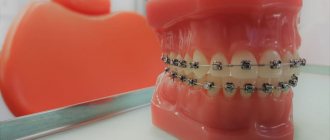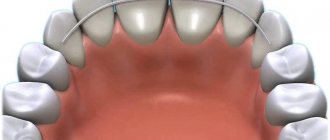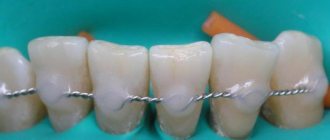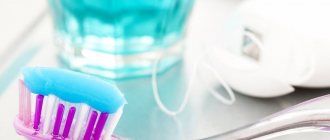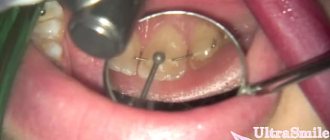In correcting dental malocclusion, the retention stage is very important. It is necessary in order to consolidate the results achieved by wearing braces. While wearing braces, teeth move under pressure. In this case, old tissues are torn and new ones are formed. Once the braces are removed there is no more pressure. There is a risk that the teeth will return to their original position.
Retainers help avoid this situation. They help teeth secure themselves in their new position. As a rule, the retention period lasts 2 times longer than treatment with braces. But the exact period is determined by the doctor depending on the complexity of the clinical case.
Retainers on the jaw
A dental retainer is a removable or non-removable special device made of acrylic material or wire, fixed on the inside of the teeth, designed to prevent relapses, which may be caused by the growth of bones, alveolar processes, displacement of rows, and bad habits.
Requirements for dental retainers
:
- reliable fixation of organs in a new position;
- minimal impact on phonetics, articulation, aesthetics;
- possibility of changing the wearing mode (dosed/round-the-clock);
- minimal restriction on unit mobility;
- a dental retainer should not provoke caries or inflammatory reactions;
- the material used must have good resistance to bacterial attack.
Adaptation occurs in a short time: the device does not cause discomfort, is invisible in the oral cavity, does not spoil the appearance, and does not interfere with chewing functions.
How much does the design itself cost?
For the retention period, two types of retainers are used: removable and non-removable .
Removable structures are cheaper to maintain, as they do not require the involvement of a dentist or any special equipment for their installation and removal.
Fixed structures can only be installed, removed, or replaced in a dentist’s office, which affects the final cost of the service.
Fixed
Unlike removable retainers, the non-removable type has only a few models that resemble each other in appearance, but have different prices:
- Classic retainers. They are a metal arch that is fixed on the lingual (inner) side of the front teeth. Installation of this model will cost approximately 5 thousand rubles.
The reasonable cost is due to the simplicity of the device and ease of installation. To make an arc, casts are made, on the basis of which a working model is formed. Then a retention arch is twisted from many strands of thin wire.Fixation is carried out using a durable composite directly onto the enamel. For fastening strength, it is preferable to use glue designed for installing braces, which will slightly increase the cost.
- Ribbon tape. Its effect is similar to the classic version of a retainer. Only in this case, instead of a metal arc, a special fiber system made of highly aesthetic, durable material is used.
To produce this fiber, special equipment is required, which increases the price.In addition, installing Ribbon tape implies the need to prepare each tooth to form a longitudinal groove in it where the structure will be fixed.
Preparation will also be included in the total cost, which averages 10 thousand rubles .
Removable
At the moment, almost every dental clinic can offer a large number of different retainers, among which you can choose both classic-type models and completely non-standard samples.
The most popular designs are::
- Trainers – are a one-piece construction designed for putting on more than two jaws at once. It is used as a retention device only at night, during sleep.
The devices do not require the taking of impressions and the cost of procedures performed in a dental laboratory. They are made by the manufacturing company according to a standard template in several sizes from hypoallergenic elastic silicone.Each individual model is the same design, only of a different volume. Despite the fact that manufacturing a trainer is considered inexpensive, the cost of the product is still not small and is within the range of 4–6 thousand rubles .
This is explained by the demand for the product, since trainers are capable of not only maintaining the result of bite correction, but also completely eliminating myofunctional problems.
- Retention mouth guards - this is a more expensive design than the previous version, its average price is 10 thousand rubles. Manufacturing the design will add to the price list the cost of taking impressions, making a diagnostic model and the materials used.
The plastic model made from Bioplast is considered more economical; it is flexible and has low strength.Another model has a two-layer coating, which makes it more rigid and at the same time retains shock-absorbing properties, preventing injury to the tissues of the oral cavity. Such a device is a more expensive product, but it is also more durable.
- Retention plates – the most common option due to its availability. The cost of such a device starts from 4 thousand rubles. The device is intended for use on the upper jaw only.
The device consists of several main parts: an acrylic base, a retention arc and fixing elements. In this case, the cost will be influenced by the material used to make the arc and the method of fixing the plate.The lowest cost will be for an arc made of an alloy based on nickel and chromium. Also, the cost can be increased if clasps were installed on the plate as fixing elements.
In addition, it should be taken into account that structures are made only on an individual basis, with impressions taken and the involvement of a dental laboratory in the process.
- Covering retainers are the simplest option, consisting of a metal arch covered with a protective plastic layer.
The arch is bent in such a way as to form a frame for teeth that require strengthening. When installed, the frame covers both the vestibular and lingual surfaces. The cost of this design is equal to retention plates and averages 5 thousand rubles .
Fixed retainer
It is used in case of predictable instability of the row, with planned long-term retention. It is a structure assembled from rings/crowns that limit the working area and a tangential wire secured with filling material.
Indications
:
- patient indiscipline;
- stabilization of the position of the lower incisors;
- control of diastema closure.
Fixed systems are demanding in terms of hygiene, but give excellent results, since the teeth are in a fixed position during the treatment process.
Disadvantages and advantages:
- no discomfort during installation and subsequent operation;
- constant impact on the tooth, which increases the effectiveness of treatment;
- there are no visual signs of the product being in the mouth;
- quick adaptation to the device.
The disadvantage of a non-removable dental retainer is the need to visit the dentist and periodic damage to the wire.
Fixed systems
Fixed retainers are used after the treatment of complex malocclusions. They are installed in a dental office. The orthodontist uses a special glue to fix a metal wire on the inner surface of the teeth. This design is completely invisible and does not cause discomfort while wearing.
While wearing fixed structures, the patient must follow several rules:
- Ensure normal oral hygiene. Teeth with a permanent retainer are cared for in the same way as with braces, so patients do not experience any difficulties.
- Have it professionally cleaned twice a year. The retainer interferes with normal hygiene, so cleaning by a hygienist is mandatory.
- Visit your orthodontist twice a year for an examination. He evaluates the result of retention, checks the quality of fixation of the structure, and secures it if necessary.
Visits to the orthodontist cannot be neglected. After bite correction, teeth tend to return to their original position. If the retainer comes loose, it will happen in about 4 days. The entire treatment result will be lost.
Another type of modern non-removable structures are interconnected lumineers. The advantage of this method is high aesthetics. The smile looks even and beautiful, while lumineers reliably hold the teeth in the desired position and prevent them from moving. When the retention period is over, the structure can be disconnected. In this case, the lumineers remain on the teeth. This method differs from wire retainers in its higher cost, but if the aesthetics of your smile is important to you, we recommend choosing it.
Removable retainer
A system consisting of a plastic base (plate) with/without clasps and adjustment loops. Depending on the situation, additional elements are introduced into the design: vestibular arch, tongue barrier.
Indications
:
- stabilization of ranks in all segments;
- control of the position of the incisors;
- maintaining closed spaces after extraction of the first molars.
A removable retainer is easy to care for; it holds each unit firmly and does not require constant wearing.
Disadvantages and advantages:
- can be worn for several hours a day (regularity/timing is determined by the doctor);
- easy to clean with paste and brush;
- allows you to take a break from the presence of structures in the oral cavity after treatment with braces.
Among the disadvantages of installing a removable dental system: unaesthetic appearance, ineffectiveness in maintaining the result of correcting an incorrect deep bite, can provoke allergies, irritation of the mucous membrane, and impaired diction.
Answers to popular questions
Can a retainer cause tartar to form on my teeth?
No, he can not. But if you don't take good care of your teeth, you run the risk of developing caries.
Why does the doctor prohibit MRI?
If you have a metal retainer, MRI is not allowed, as the equipment generates powerful magnetic fields. If the retention apparatus is made of fibrous non-metallic compounds, then there is no prohibition.
What to do if your retainer comes off?
A loose retainer should be returned to its place as quickly as possible, especially if treatment with braces has only recently ended. When wearing a retention structure for a long time, it is acceptable to wait a few days, but you should not delay it either.
Is it possible to do without a retainer?
No you can not. The teeth will return to their original position, which means that orthodontic treatment was carried out in vain.
Do wearing retainers hurt?
No. Patients stop noticing the wire already 2-3 days after installation. Removable options also do not cause discomfort when worn.
Did not find an answer to your question?
Orthodontic splint
Used for positional retention of teeth. After removing the braces and installing a permanent dental retainer, the dentist takes impressions from which a model of the mouthguard is made. The splint should be worn for several years, putting it on every night.
In most cases, the device is worn on the upper jaw, since the lower units change their position over 2-3 years, forming a functional closure.
Types of caps:
- standard. Mass-produced products can be used immediately after purchase. Disadvantages: they do not take into account the anatomy of the row structure, therefore they are not suitable for all patients;
- thermoplastic. They are mass-produced and are distinguished by their ability to adopt the natural structure of the series;
- individual. Effective, accurate, most comfortable, repeating all the positional features of the organs in the oral cavity.
What factors influence?
The cost of each specific retainer model may be influenced by the following factors :
- material used to make the structure;
- design features of the model;
- indication: for one or two jaws.
The total cost of the service to consolidate results using orthodontic retainers, in addition to the price of the device itself, will additionally include payment for preparatory procedures, diagnostics, treatment, installation, removal, etc.
Also, it is worth considering that the amount may vary depending on the status and territorial location of the dental clinic .
What to choose: retainers or mouth guards after braces, read in the next publication.
In a separate article we will talk about the cost of mouth guards for teeth straightening.
Here https://orto-info.ru/sistemyi-vyiravnivaniya-zubov/breketyi/rezultatyi-lecheniya-foto-do-i-posle.html you will find opinions on the effectiveness of the method and photos of the condition of the teeth after wearing braces.
Causes of relapses
- excessive tilt of the frontal group units and overstrain of the oral muscles;
- left “eights”, which, when erupting, cause displacement of organs;
- expansion between “threes” - the more it increases, the more rapidly it contracts after correction, which is fraught with crowding;
- rotation of teeth (rotations around an axis);
- violation of the norm for maintaining the natural shape of the mandibular arch - retention devices only in 50-60% of cases repeat its configuration - it tends to return to its original position after 10-12 years;
- jaw growth. If the correction is completed in adolescence, with the vertical type of growth against the background of an open bite, a relapse is possible, and the horizontal type causes a deepening of the incisal overlap with age, therefore such anomalies require observation until the patient is 20 years of age;
- unresolved deviations in the articulation of the tongue when chewing food and swallowing;
- poor quality correction. With severe crowding, no space was created in the row, which led to the units tilting forward; after correction, a significant gap remained between the lower/upper incisors, which caused the upper teeth to return to their original position.
To prevent relapse, you must follow all recommendations, maintain discipline, and see an orthodontist once every six months. If displacement cannot be avoided, the dentist will suggest suitable re-treatment options.
Conditions for successful retention
:
- identifying the causes and factors that provoked the orthodontic defect. If they are not eliminated in time, there will be no lasting result - the teeth will become crooked again;
- competent correction. An inadequate therapeutic regimen or errors when correcting a bite with a brace system can cause unstable location;
- optimal design of the retention system.
Retainers: what they are and why they are needed
Retainers are the general name for orthodontic appliances that are worn after bite correction with braces. This is necessary to prevent the teeth from returning to their original position. And this is exactly what happens if the retention period is excluded from the general treatment plan.
During the correction process, braces, under the influence of a metal arc, pull the teeth - move, turn, straighten, and the correct bite is formed externally. However, bone tissue, ligaments and muscles are inert. It takes time for the structures to rebuild, the bone around the tooth root to change, and muscle memory to disappear. The retainer fixes the teeth in the correct position, preventing them from moving.
Retainer installation
The removable system does not require a specific installation procedure; if necessary, the patient removes/puts it on independently. The fixed structure is attached after removing the brace system and sanitizing the oral cavity.
Installation is possible in two ways - indirect and direct. Direct involves the installation of retainers without accompanying manipulations. Indirect takes place in several stages:
- taking and making impressions;
- making a product from a cast, giving it a jaw configuration;
- installation, polishing.
The cost of installing removable and non-removable retainers consists of many factors: prices for additional procedures (diagnosis, treatment, professional cleaning), method of fastening, type of system. The final price tag for the service varies between 5-20 thousand rubles.
Removable systems
There are two types of removable systems – plates and mouth guards. They differ in their design. The plate is a plastic structure with a metal bracket. They are worn only during the day. The plate must be removed when eating. Plates are well suited for retention after correction of complex malocclusions.
Mouthguards are made from different materials - plastic, silicone, gels with a film or fibrous structure. The most physiological ones are thermoplastic structures. Before installation, they are kept in hot water. In the mouth, the mouthguard cools down, shrinks and presses tightly against the surface of the teeth, perfectly following their shape.
Unlike plates, they are soft and transparent, almost invisible in the mouth. At first, the mouth guard is worn daily. Once the result of the correction is established, you can wear it several times a week.
The simplest and cheapest option is standard pharmacy mouth guards. They differ in size, but it is impossible to adjust such designs to individual characteristics. You may feel uncomfortable while wearing it. Individual mouthguards are made from impressions. They are more expensive, but completely replicate the anatomical features of the patient.
Dentistry for those who love to smile
+7
Make an appointment
Wearing time
The optimal option is to fix the retainer on six frontal units, the simplified option is to fix it on four incisors, but in this case there is a risk of the canines returning to their original location.
To prevent the opening of the gap in the tooth extraction area, premolars are connected to the device:
- Retainers on the upper jaw should last 5-10 years. If, during correction, good closure in the lateral/anterior sections is achieved, treatment continued for 1.5-2 years, the retention period is reduced to 2-3 years;
- Duration of wearing on the lower one is at least 10-15 years. This is due to the instability of the incisors and their predisposition to relapse. .
What to wear after braces: types of retainers
Aza&Buka pediatric dentistry provides removable and non-removable retainers.
Fixed retainers are wires that are attached to the inside of the teeth. The arch connects all the front teeth into a single system. It is attached to the enamel with a special composite composition. The wire retainer is practically invisible on the teeth, does not affect diction, and does not interfere with meals. The only thing that is required from the patient is to thoroughly clean the space under the wire, use dental floss with hard tips and an irrigator.
Advantages of the non-removable option:
- constant impact on teeth;
- no risk of return of abnormal bite;
- simple quick installation;
- easy adaptation;
- complete invisibility.
Materials for the manufacture of non-removable retention products:
- medical steel;
- polyamide or polyethylene fiber;
- thin carbon threads;
- fiberglass.
Removable retainers are orthodontic devices that hold teeth in the correct position. The most popular are aligners with a metal arch. They must be worn constantly, taking off only during meals. Less commonly, an orthodontist offers mouth guards. Mouthguards simultaneously fix the teeth of both jaws - it is impossible to speak or eat with them. They are prescribed for night wear only. The third option is a plate with canine retainers to hold the teeth in the correct position. All removable retainers are made individually, using impressions of the patient, to accurately fix the teeth in the correct bite position.
Advantages of a removable design:
- no need for constant wearing;
- rest from orthodontic appliances;
- easy care without special equipment.
In some cases, orthodontists combine removable and fixed solutions. A non-removable wire retainer is placed on the lower teeth, and a removable appliance is placed on the upper teeth.
What should you not do when wearing it?
After installation, wearing a removable or fixed retainer requires compliance with rules similar to the use of braces. Forbidden:
- frequently consume hot drinks/meals, solid foods;
- smoking, chewing hard objects with teeth;
- leave the removable structure outside the case;
- store near heating devices, heating radiators;
- carry out independent repairs/removal of fixed restorations;
- change the wearing regimen prescribed by the orthodontist.
Care
When using the product, do not use a toothpick, floss, or whitening paste. A removable dental retainer should be thoroughly cleaned after eating, use an irrigator, and be sure to brush during hygiene activities. In the event of a breakdown, you must immediately contact your dentist to replace or glue an additional segment of the structure.
If a non-removable retainer breaks, a characteristic crunching sound occurs when eating, and the structural element can scratch the tongue. You cannot put off a visit to the doctor - teeth tend to change their position significantly even within a few days.
It is recommended to completely remove the device in case of irreversible damage to replace it with a new one at the end of the required wearing period.
Features of the retention period
Duration. The period of use of retention devices is determined by the treating orthodontist. The more the dental system has been changed, the longer it will be. Additionally, it is influenced by the state of the dental system, the speed of adaptation of its tissues to the new position of the teeth, and other features. The retention period can last as long as the main phase of treatment, or longer.
Daily hygiene. This is done in the same way as when using braces. The constant use of metal plates fixed to the surface of the enamel can increase the risk of its demineralization, accumulation of soft plaque, and the appearance of tartar. To keep your teeth healthy, you need to visit the dentist once every six months for a preventive examination, professional hygiene, and enamel remineralization. These visits are combined with control examinations by an orthodontist, who can adjust the retention apparatus, change recommendations for its use, etc. If a non-removable retainer comes off, causes discomfort, etc., an orthodontist is visited urgently.
Additional treatment. Together with mouthguards or retainers, functional orthodontic devices (regulators, bionators, activators, etc.) can be used at the final stage of treatment. They are installed to finally align the position of the teeth while the adaptation process is underway.
During the retention period, the shape of the dentition no longer changes, and there will be no visible, noticeable results at this stage of treatment. It is important so that the teeth acquire a stable position, and the dental system itself successfully adapts to it.
Dentists at the Dentospas clinic use individually manufactured devices during the retention period, which ensures control over the stability of the teeth. This ensures that the results of orthodontic treatment will not be lost, and the patient’s smile will remain beautiful for a long time.
Prices for installing retainers
To calculate the cost of permanent dental retainers, sign up for a consultation at Dr. Razumenko’s dentistry in Moscow. To do this, fill out an application on the website or call.
| Code no. | Name of procedures | Unit of measurement | Cost, rub. |
| 901 | Initial oral consultation with a dentist - orthodontist | 2 500,00 | |
| 914 | Gluing a retainer (bracket) | 1 tooth | 850,00 |
| 964 | Joint splint Splint | 27 000,00 | |
| 965 | Retention tray transparent | 1 person | 6 000,00 |
| 966 | Mouthguard for the treatment of bruxism | 15 000,00 | |
| 967 | Sports mouthguard 5 layers | 20 000,00 | |
| 968 | Sports mouthguard for children | 10 000,00 | |
| 969 | Mouthguard 3X layer | 15 000,00 | |
| 976 | Small course (up to 14 aligners) made in the Invisalign laboratory | 220 000,00 | |
| 977 | Full course (from 14 aligners) made in the Invisalign laboratory | 280 000,00 |
* The prices indicated on the website are not a public offer. The exact cost of treatment can only be determined at an appointment with a doctor.
Prices for treatment in Moscow full price list
Share on social media networks:
Article Expert:
Oganesyan Diana Feliksovna
Dentist-orthodontist. He regularly improves his professional level and studies modern methods of orthodontic treatment at international seminars and conferences of outstanding orthodontists in the world. He is a member of the Italian Society of Orthodontists (SIDO) and the European Aligner Association (EAS).
Work experience over 6 years
Installation cost
The main cost of the total price list for the service often falls not on the product, but on the installation procedure, which, as a rule, is carried out immediately after removing the braces.
Between these two procedures, the dentist performs a number of paid manipulations, the cost of which will vary in each specific case.
Diagnostics
This period is mandatory , as it allows you to evaluate the quality of the result obtained and the condition of the tissues surrounding the tooth. In addition to a visual examination, the dentist prescribes an x-ray examination.
In most cases, a panoramic image is taken using a regular x-ray. If retention is carried out on a child or a pregnant woman, then a more expensive device is used - a visiograph.
In some situations, an orthopantomogram may be necessary. On average, the cost of this period can be from 1000 rubles .
Sanitation
Sanitation may be required only when the dentition is in unsatisfactory condition . Wearing trainers leads to the accumulation of numerous bacteria, which can aggravate the situation and lead to dental complications.
At this stage, it may be necessary to treat carious cavities, restore the surface after injuries, and relieve inflammation from periodontal tissues.
In this situation, it is impossible to determine even the approximate cost of this period, because it is strictly individual.
Professional cleaning
This stage is mandatory , since long-term wearing of braces implies the formation of deposits in the area of the structure due to a large accumulation of bacteria.
To restore the aesthetics of enamel and reduce the risk of developing dental pathologies, mechanical teeth cleaning is performed using curettes, ultrasound and other techniques.
Depending on the method used, the price for this stage can range from 50 to 700 rubles per tooth .
In what cases are plates prescribed for straightening teeth in adults, the pros and cons of the method.
In the next review we will talk about the T4A dental trainer.
Follow the link https://orto-info.ru/sistemyi-vyiravnivaniya-zubov/lechebno-profilakticheskie-apparatyi/treyneryi-dlya-tsena-na-razlichnyie-vidyi.html you will find out how much dental trainers cost and what it depends on .
Preparatory procedures
To place retainers, it is necessary to prepare the tooth surface. To do this, the enamel is treated with a remineralizing agent, then etched and dried.
All drugs used at this stage are usually immediately included in the total cost of the service .
A separate calculation may be made in a situation where, during the procedure, the patient developed an allergy, and the clinic’s arsenal did not find a material of similar cost.
Installation process
Installation is the final stage , which includes fixing the retainers. Its cost will depend on the chosen model and mounting method.
When installing Ribbon tape, the dentist will have to work more precisely, which will affect the duration of the procedure. The installation method also plays a significant role here.
The cheapest option would be the direct method, when the retainers are attached directly into place . More expensive, but allowing installation without errors, is an indirect method, when the device is first fixed on individual silicone impressions and then transferred from them to the teeth.
Depending on this, the cost of this stage can vary from 3 to 10 thousand rubles .
How to perform indirect fixation of a retainer, watch the video:
We recommend that you read
Invisalign
Braces
Correction of bite with mouth guards
Damon braces

